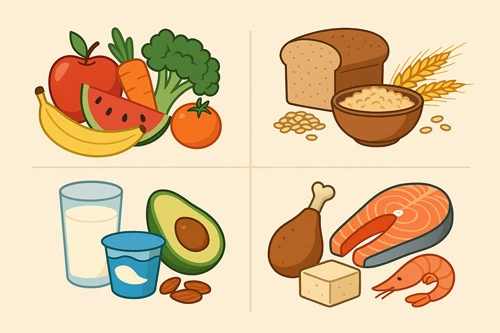Introduction
In recent years, the low carb diet has emerged as one of the most popular and scientifically supported approaches for weight loss and overall health improvement. Unlike traditional diets that often focus on calorie counting or low-fat eating, the low carb diet emphasizes significantly reducing carbohydrate intake, encouraging the consumption of healthy fats and proteins instead. This dietary strategy taps into the body’s natural ability to burn fat for energy, leading to more effective and sustained weight loss.
Many people begin their journey by searching for a low-carb diet food list to understand which foods are allowed and which should be avoided. Additionally, those managing chronic conditions such as type 2 diabetes often look for specific resources like a menu for diabetics or even a free diet plan menu PDF to guide their meals. Such structured plans make it easier to stick to the diet and enjoy a variety of delicious, satisfying foods without worrying about exceeding carbohydrate limits.
One common question that arises is what is considered a low-carb diet for a woman? Generally, women are advised to consume between 20 to 100 grams of carbohydrates daily, depending on their age, activity level, and health goals. Some people prefer to adopt a low sugar diet to minimize blood sugar spikes and cravings, which is especially beneficial for those with insulin resistance or diabetes.
The benefits are numerous and well-documented. Not only does it support rapid weight loss in 2 weeks, but it also promotes better blood sugar control, improved heart health, and increased energy levels. However, like any diet, it is not without potential drawbacks. Being aware of possible side effects and knowing how to manage them is essential for long-term success.
In this comprehensive guide, you will find everything you need to know about the low carb diet—from detailed foods lists and tasty recipes to practical menus, a useful diet chart, and tips on managing side effects. Whether you are a beginner or looking to refine your eating habits, this guide will help you achieve your health and weight loss goals confidently and sustainably.
2. What is a Low Carb Diet?
A low carb diet is a dietary approach that significantly reduces carbohydrate intake, usually replacing those calories with proteins and healthy fats. Carbohydrates are found in foods like bread, pasta, rice, sugary snacks, and many processed foods. When you reduce these carbs, your body shifts from using glucose as its main energy source to burning fat, a metabolic state sometimes called ketosis. This shift helps many people lose weight effectively and improve their metabolic health.
One of the common questions people ask is, what is considered a low-carb diet for a woman? Generally, women consume between 20 to 100 grams of carbohydrates per day on a low carb diet. This range can vary depending on individual factors like activity levels, age, and health goals. For example, active women or athletes might consume closer to 100 grams per day, while those aiming for rapid weight loss might restrict carbs to under 50 grams daily.
It’s important to understand how a low carb diet compares to other popular diets, such as a low fat low carb diet or a low fat high carb diet. In a low fat high carb diet, the primary energy source comes from carbohydrates, and fat intake is limited. Conversely, a low carb diet reduces carbohydrate intake substantially and increases fats and proteins to compensate. Some people try combining low fat and low carb approaches, but this can be challenging because these diets have conflicting goals.
The benefits of a low carb diet extend beyond weight loss. Studies show that a low-carb diet for diabetes type 2 can improve blood sugar control by reducing insulin spikes and increasing insulin sensitivity. People following a low carb diet for diabetics often report better energy levels, fewer cravings, and improved metabolic markers.
Another key advantage is that a low carb diet helps reduce hunger by stabilizing blood sugar levels. When you avoid high-carb foods that cause spikes and crashes in blood sugar, you tend to feel fuller longer and eat fewer calories overall. This natural appetite suppression is a big reason why many find success with this approach.
In summary, a low carb diet is not just about cutting carbs; it’s about shifting your body’s fuel source to burn fat, which can support weight loss, improve blood sugar control, and enhance overall health. Whether you are a woman wondering about your ideal carb intake or someone managing diabetes, understanding these principles will help you create a sustainable eating plan that fits your lifestyle.
learn more: The Galveston Diet: Menopause Health Plan, Recipes & Reviews
3. Low-Carb Diet Food List
A successful low carb diet starts with knowing which foods to include and which to avoid. Having a clear low-carb diet food list is essential for making informed choices that help maintain low carbohydrate intake while providing necessary nutrients.
Foods to Include
Proteins: High-quality proteins are a cornerstone of the low carb diet. This includes meats such as beef, pork, lamb, and poultry like chicken and turkey. Fish and seafood—especially fatty types like salmon and mackerel—are rich in omega-3 fatty acids, which support heart health. Eggs are also a versatile, nutrient-dense protein source suitable for any meal.
Healthy Fats: Since the low carb diet reduces carbs, fats become a primary energy source. Healthy fats include olive oil, avocado oil, nuts and seeds (like almonds, walnuts, and chia seeds), and fatty fish. Full-fat dairy products such as cheese, butter, and Greek yogurt (in moderation) are also excellent choices.
Low-Carb Vegetables: Vegetables play a crucial role in providing fiber, vitamins, and minerals while keeping carbohydrates low. Leafy greens like spinach, kale, and arugula are ideal, along with cruciferous vegetables such as broccoli, cauliflower, and Brussels sprouts. Other low-carb options include zucchini, cucumbers, peppers, and asparagus.
Beverages: Water, herbal teas, and black coffee are suitable low-carb beverage choices. Avoid sugary drinks and fruit juices, which can quickly add to your carb count.
Foods to Avoid or Limit
-
Grains: Bread, pasta, rice, cereals, and other grain-based foods are high in carbohydrates and generally restricted on a low carb diet.
-
Sugary Foods: Candy, sweets, pastries, and desserts typically contain high amounts of sugar and should be minimized.
-
Starchy Vegetables: Potatoes, corn, and peas have higher carb content and are usually limited.
-
Processed Foods: Many processed foods contain hidden sugars and carbs, so it’s best to read labels carefully or avoid them altogether.
For individuals managing blood sugar or diabetes, following a low carb-low sugar diet is especially beneficial. This approach limits not only carbs but also added sugars, reducing blood sugar spikes and cravings.
Having a comprehensive low-carb diet food list empowers you to make delicious and satisfying meals that keep your body in fat-burning mode. Whether you’re following a low carb diet for diabetics or simply aiming to lose weight, choosing the right foods is the foundation of your success.
Next, we will explore practical low-carb diet menus for diabetics and others seeking structured meal plans.
4. Low-Carb Diet Menu and Plans
Having a clear and practical low-carb diet menu is vital for successfully following this eating plan, especially for individuals managing specific health conditions like diabetes. A well-structured low-carb diet menu for diabetics focuses on meals that maintain blood sugar stability while keeping carbohydrate intake low.
Many beginners find it helpful to use resources like a free low-carb diet plan menu PDF, which often includes detailed meal plans, grocery lists, and recipes designed to simplify adherence to the diet. These guides help reduce guesswork and provide variety, making it easier to stick to the diet long-term.
Sample 7-Day Low-Carb Diet Menu
Day 1
-
Breakfast: Scrambled eggs with spinach and feta cheese
-
Lunch: Grilled chicken salad with olive oil and avocado dressing
-
Dinner: Baked salmon with steamed broccoli and cauliflower
Day 2
-
Breakfast: Greek yogurt topped with walnuts and a few raspberries
-
Lunch: Turkey lettuce wraps with avocado and cucumber slices
-
Dinner: Beef stir-fry with mixed low-carb vegetables like zucchini and bell peppers
Day 3
-
Breakfast: Omelette with mushrooms, cheese, and herbs
-
Lunch: Tuna salad with celery, mayonnaise, and lettuce
-
Dinner: Grilled shrimp with sautéed asparagus and a side of mashed cauliflower
Tips for Planning Your Menu
When planning your low carb diet menu for diabetics or anyone looking to reduce carbohydrates, it’s important to balance macronutrients to maintain energy and satiety. Include a good mix of proteins, healthy fats, and plenty of low-carb vegetables.
Remember, while carb counts are important, quality matters too. Choose whole, minimally processed foods to maximize nutrition and health benefits.
For those with type 2 diabetes, following a low-carb diet for diabetes type 2 can improve insulin sensitivity and reduce reliance on medications. Structured menus help ensure consistent carb intake, which supports blood sugar control.
By using meal plans like these and tools such as a low carb diet chart, you can take the guesswork out of dieting and focus on enjoying your meals and progress.
Next, we will discuss the numerous benefits of a low carb diet and how it can positively impact your health.
learn more: Calorie Deficit Diet: Your Ultimate Guide to Sustainable Weight Loss
5. Benefits of a Low Carb Diet
The low carb diet has gained widespread popularity due to its numerous health benefits, making it more than just a weight loss strategy. One of the primary advantages is its effectiveness in promoting rapid weight loss, often visible within just a few weeks. Many people experience significant low-carb diet weight loss in 2 weeks as their bodies transition from burning carbohydrates to burning fat for energy.
This diet is especially beneficial for individuals with type 2 diabetes. A well-formulated low-carb diet for diabetes type 2 helps regulate blood sugar levels by reducing the spikes caused by high carbohydrate intake. People following a low carb diet for diabetics often report better blood glucose control, which can lead to decreased medication needs and improved overall health.
Beyond weight and blood sugar control, the low carb diet benefits extend to cardiovascular health. Studies have shown that low carb diets can improve cholesterol profiles by increasing HDL (“good” cholesterol) and reducing triglycerides. This contributes to a lower risk of heart disease.
Additionally, many individuals report increased energy levels and improved mental clarity while on a low carb diet. By stabilizing blood sugar and insulin levels, a low carb-low sugar diet helps prevent energy crashes and sugar cravings, promoting sustained focus and well-being throughout the day.
Compared to other dietary approaches, such as a low fat high carb diet, low carb diets have been found to be more effective for long-term weight maintenance and metabolic health.
In summary, adopting a low carb diet can provide substantial benefits for weight loss, diabetes management, heart health, and overall vitality. These advantages make it a compelling choice for anyone looking to improve their health naturally and sustainably.
6. Side Effects of a Low Carb Diet
While the low carb diet offers many health benefits, it is important to be aware of potential low carb diet side effects, especially during the initial adaptation phase. When the body switches from burning carbohydrates to burning fat for energy, some people experience what is commonly called the “keto flu.” Symptoms may include headaches, fatigue, dizziness, irritability, and difficulty concentrating.
Another common side effect is digestive changes, such as constipation, which can occur due to reduced fiber intake when cutting out high-carb foods like grains and legumes. Including plenty of low carb diet foods rich in fiber—such as leafy greens, nuts, and seeds—can help prevent these issues.
Some individuals choose a low fat low carb diet to mitigate side effects by balancing fat intake with reduced carbs. This approach might be more sustainable for those who find a very high-fat diet challenging.
It is also essential to stay well-hydrated and maintain proper electrolyte balance. Drinking enough water and consuming foods rich in potassium, magnesium, and sodium can reduce symptoms and support overall health.
Before starting a low carb diet, especially if you have pre-existing medical conditions or are taking medications, consult with a healthcare professional. Regular monitoring and adjustments can help manage any side effects effectively and ensure the diet is safe and beneficial.
Understanding and managing these side effects will help you enjoy the full advantages of the low carb lifestyle without unnecessary discomfort.
7. Low Carb Diet Recipes
One of the most enjoyable aspects of following a low carb diet is discovering delicious and satisfying meals that fit your nutritional goals. There are countless low carb diet recipes available that help make the transition to this lifestyle easier and more enjoyable.
Popular recipes often include protein-rich dishes combined with low-carb vegetables and healthy fats. For example, grilled salmon with avocado salsa, cauliflower rice stir-fry, and zucchini noodles with pesto are all flavorful, nutritious options that fit perfectly into a low carb eating plan.
Including a variety of foods from the low carb diet foods list ensures you receive a balanced intake of vitamins, minerals, and fiber, which supports overall health. For those managing diabetes, these recipes can also help maintain steady blood sugar levels by avoiding high-carb ingredients.
Here are a few easy recipe ideas to get you started:
-
Breakfast: Omelette with spinach, mushrooms, and cheese. Packed with protein and low in carbs, it’s a great way to start the day.
-
Lunch: Chicken Caesar salad without croutons, using a homemade dressing with olive oil and lemon.
-
Dinner: Beef stir-fry with broccoli, bell peppers, and a soy-ginger sauce served over cauliflower rice.
Experimenting with herbs, spices, and cooking methods keeps your meals exciting and varied, preventing diet fatigue. Whether you prefer simple meals or gourmet dishes, the low carb diet offers endless possibilities to suit your taste and lifestyle.
Trying new low carb diet recipes regularly can help you stick to your goals while enjoying every bite.
learn more: Hashimoto Diet: Your Essential Guide to Thyroid Health
8. Low Carb Diet Chart
Tracking your carbohydrate intake is essential for successfully following a low carb diet, and using a low carb diet chart can make this task much easier. These charts typically list common foods along with their carbohydrate content, allowing you to plan meals that fit within your daily carb limits.
A good low carb diet chart categorizes foods into groups such as proteins, fats, low-carb vegetables, and foods to avoid, showing the grams of net carbs per serving. This helps you quickly identify which foods are low in carbs and which ones to minimize or exclude.
For example, leafy greens like spinach may contain less than 1 gram of net carbs per cup, while starchy vegetables like potatoes have much higher carb counts and are typically avoided. Similarly, proteins like chicken and beef contain zero or very low carbohydrates, making them staples of a low carb diet.
Using a low carb diet chart is especially helpful for people following a low-carb diet for diabetes type 2, as it allows them to maintain consistent carbohydrate intake and better manage blood sugar levels.
Many websites and health professionals offer free low-carb diet plan menu PDF downloads that include detailed charts and meal planning guides. These resources can help you stay organized and motivated.
Whether you prefer tracking carbs manually with a printed chart or using smartphone apps that incorporate these charts, having this tool at your disposal increases the chances of sticking to your diet and achieving your goals.
9. Tips for Successfully Maintaining a Low Carb Diet
Sticking to a reduced carbohydrate eating plan can be challenging, especially at the beginning. However, with the right strategies, you can maintain your new lifestyle effectively and enjoy lasting results.
Plan Your Meals Ahead
One of the most helpful habits is meal planning. By preparing your menus in advance, you avoid last-minute decisions that might lead to high-carb food choices. Creating a weekly grocery list based on nutritious ingredients ensures you always have healthy options available.
Focus on Whole, Nutrient-Dense Foods
Choosing whole foods such as fresh vegetables, quality proteins, and healthy fats provides your body with essential nutrients and helps keep you full and satisfied. Minimizing processed foods reduces the risk of hidden sugars and unnecessary carbohydrates.
Stay Hydrated and Monitor Electrolytes
Reducing carbohydrate intake can change your body’s water and mineral balance. Drinking plenty of water and consuming foods rich in potassium, magnesium, and sodium supports proper hydration and reduces common issues like headaches or fatigue.
Incorporate Variety in Your Diet
Trying different recipes and food combinations prevents boredom and makes the eating plan more enjoyable. Using diverse herbs, spices, and cooking methods keeps meals flavorful and exciting, helping you stay motivated.
Manage Cravings Wisely
Cravings are natural but can be managed by eating balanced meals that include adequate protein and healthy fats. When a craving arises, choose low-carb snacks like nuts or cheese instead of sugary treats to stay on track.
Listen to Your Body and Adjust
Everyone’s body reacts differently to dietary changes. Pay attention to how you feel and make adjustments as needed. Some people find a moderate carbohydrate intake works better for their energy levels and sustainability than very strict restriction.
Seek Support and Educate Yourself
Joining online communities, consulting dietitians, or reading reliable resources can provide encouragement and knowledge. Staying informed empowers you to make better choices and overcome challenges.
By applying these tips, maintaining a reduced carbohydrate lifestyle becomes easier and more sustainable, paving the way for improved health and lasting benefits.
10. Conclusion
Adopting a low carbohydrate eating plan has proven to be an effective strategy not only for weight loss but also for improving overall metabolic health and managing blood sugar levels. By carefully selecting foods from a structured list and using helpful tools such as diet charts, individuals can more easily monitor and control their carbohydrate intake. This helps tailor the diet to their specific health needs and goals, increasing the likelihood of long-term success.
Meal planning plays a vital role in maintaining consistency and variety. Structured menus—especially those designed for people with diabetes—offer practical guidance that simplifies decision-making and ensures balanced nutrition. Access to resources like free downloadable diet plan PDFs further supports individuals in staying committed to their goals.
The benefits of this eating approach extend beyond shedding pounds. Many individuals notice improvements in insulin sensitivity, which is crucial for managing type 2 diabetes, as well as enhanced cardiovascular health. Reduced sugar intake can also minimize cravings and energy fluctuations throughout the day, making it easier to adhere to the diet over time.
However, it is important to acknowledge that, like any dietary change, some people may experience side effects initially. Symptoms such as fatigue or digestive changes can often be managed by adjusting fat intake or incorporating a low fat version of the diet. Staying hydrated and ensuring adequate nutrient intake also help mitigate discomfort.
Enjoying a diverse range of recipes tailored to low carbohydrate eating ensures that meals remain enjoyable and satisfying. This variety not only prevents dietary boredom but also encourages long-term adherence, which is key to sustainable health improvements.
Before making any significant dietary changes, especially if you have pre-existing health conditions, consulting with a healthcare professional is strongly recommended. With proper knowledge, planning, and ongoing support, adopting a low carbohydrate lifestyle can be a highly rewarding choice that leads to lasting improvements in health, energy, and quality of life.






